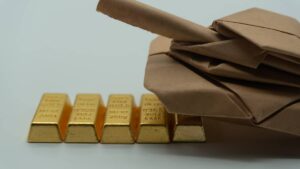TEN BAGGER: Why ASX iron ore and copper plays should stay positive on China

Pic: Lowell/Stockhead
Welcome to Ten Bagger, where Lowell Resources Fund chief investment officer John Forwood gives us his take on a sector of the ASX resources market full of value.
This month, John tells us why China’s data isn’t as negative as you may think for iron ore and copper explorers.
There have been few narratives as sustained since the end of the Covid investing era as the failure of the Chinese economy to fire up commodity markets.
The biggest millstones around the neck of the Chinese economy — though don’t let Prez Xi hear you say this — are its woeful property sales and youth unemployment numbers.
Traditionally the engine room of Chinese commodity and economic growth, the real estate sector has been humbled in recent years as waning consumer spending, widespread Covid lockdowns and inconsistent government policy have hammered the industry.
Residential floor space sold has tumbled 40% after peaking at 1.56 billion square metres in 2021, when China’s economy was indulging on stimulus that preceded a sharp economic decline brought on by 2022’s Covid lockdowns.
Youth unemployment hit a record high of 21.3% in June last year, bad enough for the Communist Party to stop reporting regular statistics.
But at the same time there are some green shoots for commodities that defy the doom and gloom befalling the Australian mining sector, especially in critical minerals where China’s stuttering economic recovery and oversupply has pressed pause on the growth narrative for lithium and rare earths prices.
Lowell Resources Fund (ASX:LRT) CIO John Forwood says there are a number of statistics which show the situation in China is not as bad for commodity markets as they may seem.
“It’s really interesting to contrast some of the negative perception of the Chinese economy with some of the actual data that you see,” he told Stockhead.
“For example, China’s electricity consumption last year was a record — up 6.7% year on year.
“Iron ore imports were also up almost exactly the same number — 6.6% year on year, and that was also a record.
“China’s copper consumption was a record in 2023 as well and that’s reflected in treatment charges for copper concentrate, down to US$20 bucks a tonne.
“In my memory, I can’t remember treatment charges been that low for copper. Those data points are really very positive.”
The case for iron ore
Through the back end of 2023 unexpectedly high rates of steel production, low stockpiles and high steel export levels sent iron ore prices paid in China back to historically strong levels in excess of US$140/t.
They’ve slid back recently, falling to US$127.10/t on Friday as the Lunar New Year keeps demand in check.
But Forwood said there were plenty of reasons to think the iron ore market was in a stronger position than analysts gave it credit for, noting the role steel would also play in the energy transition alongside EV and electrification metals like nickel, lithium, graphite, cobalt and copper.
“It’s still a magnificent price,” he said, noting China was not keeping blast furnaces operating at high utilisation rates “just to keep people employed”.
“We’ve seen in our little portfolio some iron ore plays do really nicely recently. CZR Resources (ASX:CZR), which is a Creasy backed company, has had an agreement with a Chinese-backed company called Miracle to sell its little iron ore project in the Pilbara for $100 million bucks, basically twice the market cap.”
Lowell is also in Arrow Minerals (ASX:AMD), which owns a third of Simandou North, the tenements in Guinea directly north of Simandou, the world’s largest undeveloped deposit of high grade iron ore.
It is planning to increase its stake to 60.5%, with rights to up that again to 100% secured in the September quarter. While the minnow is yet to hit the jackpot — a best hit of 12m at 60.5% Fe came in far below the 65% Fe grade of the nearby deposits held by Rio Tinto (ASX:RIO) and a slew of Chinese players — its appointment of former Atlas Iron boss David Flanagan as managing director late last year has seen its shares lift six times over off a low base.
The key to a discovery there would be the potential for Arrow to find something which could utilise billions of dollars in port and rail infrastructure which will be developed by Rio, Chinalco, Baowu, the Winning Consortium and Guinea’s Government.
“There’s been a lot of positive news out of the Simandou project,” Forwood said. “The rail and port construction seems to be moving ahead after a number of hiccups. That’s publicly stated to be open access port and rail.
“Arrrow’s a long way from port but if you can get access to rail that’s within that 10-20km of your hypothetical iron ore deposit that’s great.
“That news plus David Flanagan being one of the sector’s great promoters will assist the company in raising money and it already has, so they will be able to dedicate a lot more money and people and effort to the exploration of that project now.
“They found some indications of high grade, 60% plus, but they certainly haven’t found a deposit yet. They do need to do a significant amount of exploration and I think that both those factors will assist significantly.”
If it finds something of note, Arrow could also become a takeover target for Winning, which holds the two northern blocks at Simandou — containing 1.8Bt at over 65% Fe.
The case for copper
The other metal Forwood says looks brighter than the macro picture would suggest is copper.
It remains rangebound so to speak, dropping from over US$8400/t at the start of the year to US$8169/t on Friday, despite most analysts switching their supply-demand models from a surplus to a significant deficit after political opposition forced First Quantum to shut its 350,000tpa Cobre Panama mine in the Latin American nation at the end of last year.
“People have been calling it for a long time that 2025 could be when we start to see the squeeze in the supply-demand balance but you’re seeing and hearing on the equity side, more interest in copper,” Forwood said.
While prices remain subdued, institutional and high net worth investors are upping their bets on copper equities.
160,000tpa Capstone Copper (ASX:CSC) recently raised C$431 million in a tough market for Canadian resources stocks ahead of a planned compliance listing on the ASX.
Also seeking a dual listing on the Australian Bourse is America’s Metals Acquisition Corp, which nabbed $325 million ahead of its local float, which will bring the high grade CSA mine in Cobar to the local investment market.
They loom as two of the first companies to join Sandfire Resources (ASX:SFR) to fill the investing gap left behind in BHP’s (ASX:BHP) $9.6 billion takeover of OZ Minerals.
“Even though the copper price has been range bound and gone sideways between US$3.50-3.80/lb for an extended period, I think the big players are trying to get set and increase their exposure to copper and it’s happening now — both from the equity markets and from corporates trying to do joint ventures with juniors and increase their access to the copper project pipeline,” Forwood said.
Among the juniors in Lowell’s portfolio are Anax Metals (ASX:ANX) and Cooper Metals (ASX:CPM).
$11m capped Anax has completed a feasibility study on the restart of the Whim Creek copper and zinc mine in the Pilbara, where it has cleared environmental legacies but run into funding challenges in a stormy market. Most recently, the project developer raised $2.7 million from investors at 2c in a rights issue.
“The capital cost of the project’s north of 70 million, so it’s not nearly enough to get the project going,” Forwood noted.
“Raising development finance is still very difficult for a number of projects, and that just feeds back into the idea that every project that gets delayed or deferred makes the future supply shortfall worse.
“Hopefully Anax will benefit (if prices rise). They’re probably one of the next cabs off the rank in terms of copper developments that are shovel ready.”
While Cooper and its Brumby Ridge discovery in Queensland is earlier stage, Forwood is hopeful copper interest will filter down to genuine grassroots exploration stories.
$18m capped CPM’s shares peaked at a two year high of 44c on November 30 when it announced a ‘high grade discovery’ in a hole that struck a 71m intercept at 2.8% Cu.
Its shares have since settled back to 28c, down on a 12 month basis but 211% up on all time lows of 9c recorded on October 31.
Lowell copper and iron ore stocks

UNLOCK INSIGHTS
Discover the untold stories of emerging ASX stocks.
Daily news and expert analysis, it's free to subscribe.
By proceeding, you confirm you understand that we handle personal information in accordance with our Privacy Policy.








